WW2 US Army Litters
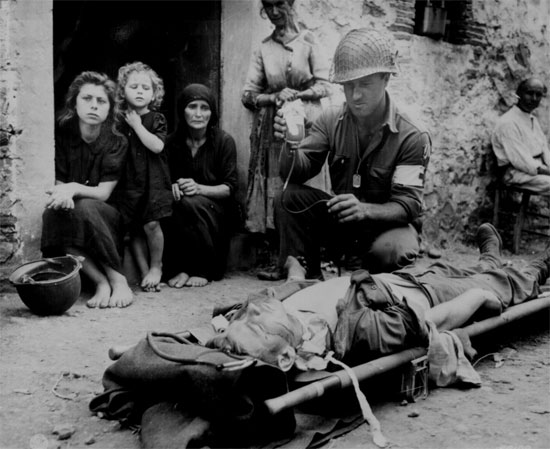
Administering plasma to Pvt Roy W. Humphrey at the 7th Infantry Regiment (3d Infantry Division) Aid Station, Sant’Agata, Sicily, August 9, 1943
Background Information:
Without a doubt one of the most useful tools for combat medics and military personnel involved in the first echelon of medical evacuation was the US Army Litter. A Litter is a Stretcher, carried by two or four bearers, for evacuation of sick and wounded.
All patients unable to walk, either with or without assistance, were classified as Litter cases. Evacuation by Litter was offered in a number of different forms, all designed to allow transportation of casualties from the battlefield to the medical installation designed for treatment as quickly and effectively as possible. This article aims to look at the various types of Litters in use by the Medical Department during World War 2.
Litter Use:
Obviously one of the most common tasks of the US Army Litter was the evacuation of wounded personnel from the frontline. This often took place in the first echelon of medical evacuation, and Litter Bearers would carry wounded men across rugged terrain to the Battalion or Regimental Aid Station where the casualty would undergo further triage. All Litters were to possess the same dimensions when open – this allowed a patient to pass through the various echelons of medical service, entailing easy movement on several types of carrier, without being removed from the Litter upon which he initiated his journey – it saved valuable time and avoided danger to the patient!

Photograph showing the use of wooden Saw Horses during operations at the 102d Evacuation Hospital near Huy, Belgium. Taken January 6, 1945.
Litters were also used once the patient had arrived at the Aid Station, often as an improvised operating table. The table would be constructed using either two Medical Chests upturned onto their end, or alternatively field-made stretcher “Saw Horses” often manufactured by the Medical Detachment personnel. An example of these field-made solutions can be seen in the photograph above.
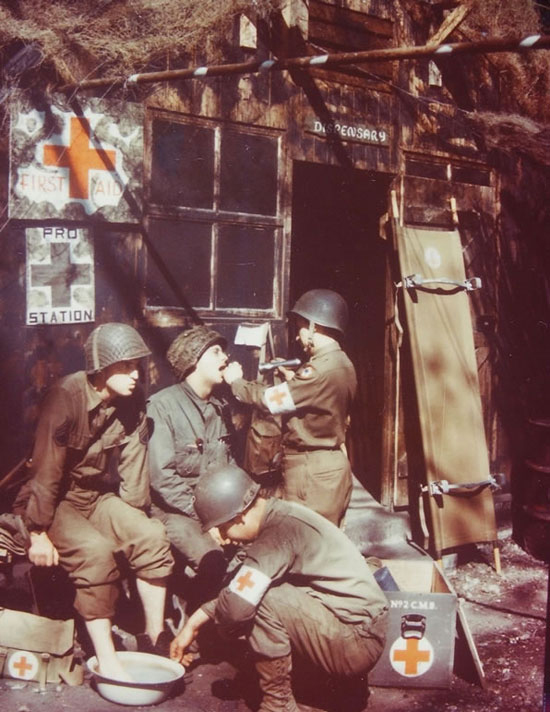
Medics set up a Dispensary at a Port of Embarkation to take care of last minute “Repairs.” England. Of interest is the Army Litter clearly visible here.Courtesy of historylink101.com
Finally Litters were used for transporting casualties whilst in moving vehicles too. For example many period illustrations and photographs can be found showing the use of improvised Litter racks attached to ¼ Ton Trucks, and it was commonplace in the ETO for these vehicles to also be used, alongside Litter Squads in the First Echelon of Medical Evacuation. Litters were also widely used in Echelon II of the Medical Evacuation, at which point the casualty was transported, more often than not using an Ambulance, to the Collecting Station and / or Clearing Stations.

Air evacuation of wounded from Iwo Jima and Okinawa to Guam.
Courtesy of historylink101.com
Finally the introduction of aeromedical evacuation towards the end of WW2 meant that the Litter’s journey was now lengthened further. In many cases, casualties would be loaded into evacuation planes using the same Litter upon which they had been removed from the battlefield. Stretcher-borne casualties would be loaded into C-47 aircraft (and other planes) and flown to the nearest Allied territory for further treatment.
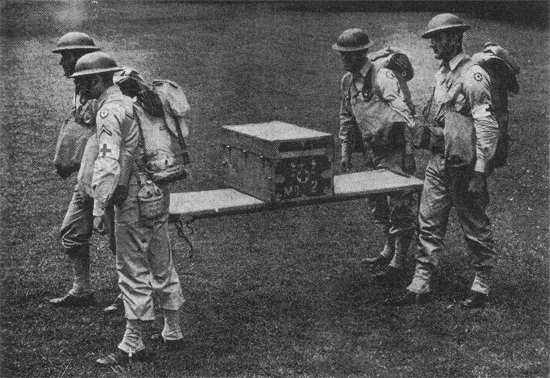
Doughboys transporting MD Chest No. 2 using the prescribed litter carrying method.
An additional, although very uncommon use of the US Army Litter was to transport the M.D. Chest between installations. For example these Chests were often heavy, and so their transportation over difficult or rugged terrain by two men alone was rather impracticable. As a result the Army prescribed a method by which the Chest was to be placed on a Litter, which in turn would be carried by 4 men.
Variations of the US Army Litter:
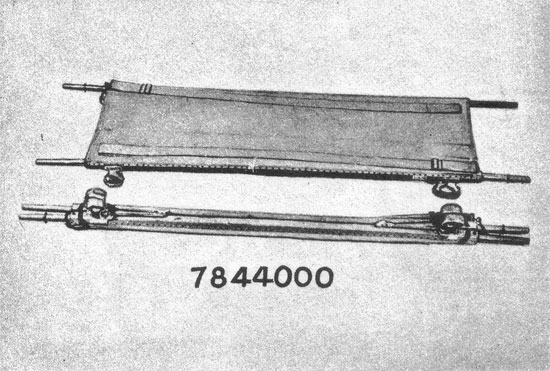
Illustration showing Item # 7844000 Litter. The illustration shows the litter both in its regular and collapsed form.
7844000 – Litter:
First pattern US Army issue Litter. This was almost identical to the version used by the Medical Department during the Great War, and featured a number of differences from its later war counterpart. The Litter was a non-folding design, consisting of two wooden poles (7 ½ feet long) with a stretched canvas bed (6 feet long and 22 inches wide), with or without a simple Greek Red Cross and black text designating the Medical Department, made taut by two jointed spreader bars. The supporting stirrups (4 inches high and 1 ¾ inches wide) were bolted to the two poles. On the left front and right rear handles, a half-round ring was fixed 4 ½ inches from the end, and between this and the canvas played the movable ring of the Litter sling. Two long straps (or slings), permanently attached to the Litter (2 ½ inches wide webbing) were equipped with a metal slide to regulate the length. One loop of the strap passed through a metal swivel, itself attached to the movable ring of the handle. The straps were intended to secure the patient onto the Litter. The weight of this Litter was approximately 22 pounds.
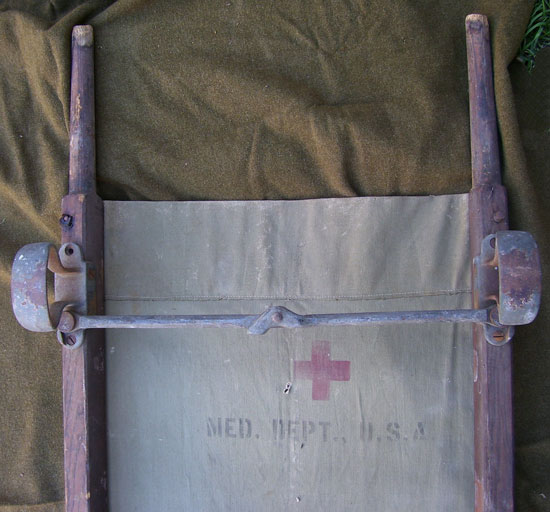
Illustration showing the Medical Department markings on the canvas of Item # 7844000
Courtesy of Roger W. Dean
The Litter (Item #7844000) consisted of the following components:
- 7845000 – Litter Brace
- 7846000 – Litter Canvas
- 7846500 – Litter Pole
- 7847000 – Litter Sling
- 7849000 – Litter Strap
- 7850000 – Litter Stud
- 7851000 – Litter Tack, 2 oz
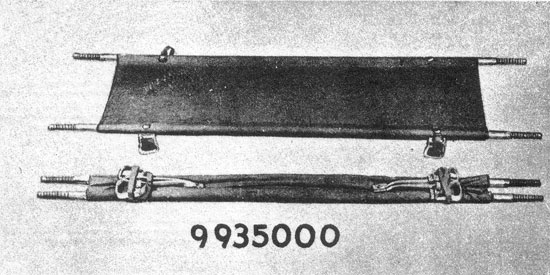
Illustration showing Item # 9935000 Litter, Straight, Aluminum.
9935000 – Litter, Straight, Aluminum:
Second pattern non-folding Litter used by the Medical Department, and introduced in 1943. The Straight Aluminum Litter consisted of tubular aluminum poles (1.54 inches in diameter and 77 inches in length) between which was stitched a canvas bed (Item # 9935200, 6 feet long and and 22 ½ inches wide) marked with a maroon Medical Department Caduceus insignia within a white circle, and corresponding service branch designation. When the Litter was grounded, it was supported by two metal stirrups (5 ¼ inches high and 3 ¾ inches wide), firmly bolted to the poles. These bolts not only secured the stirrup but also prevented the canvas bed from slipping on the pole. Straight, single-jointed spreader bars extending crosswise between the adjacent stirrups held the canvas taut. This Litter’s weight was approximately 15 pounds.
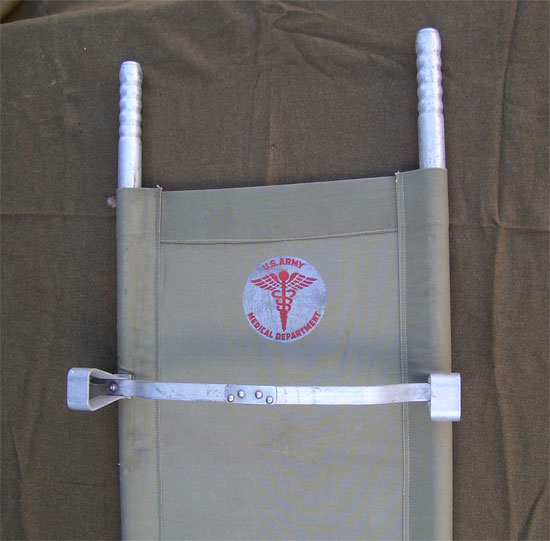
Markings shown on Item # 9935000 – Litter, Straight, Aluminum
Courtesy of Roger W. Dean
The Litter, Straight, Aluminum (Item # 9935000) consisted of the following components:
- 9935200 – Litter, Straight, Aluminum, Canvas
- 9935300 – Litter, Straight, Aluminum, Handle
- 9935600 – Litter, Aluminum, Spreader Bar and Stirrups
- 9935700 – Litter Bolt, Stirrup-Securing, for Aluminum Litter
- 9936100 – Litter Drive Pin, Handle-Securing, for Aluminum Litter
- 9936900 – Litter, Aluminum, Base Block for Stirrup
- 9937100 – Litter, Aluminum, Cap Screw for Swivel Block
- 9937200 – Litter, Aluminum, Spreader Bar
- 9937300 – Litter, Aluminum, Stirrup
- 9937400 – Litter, Aluminum, Swivel Block for Stirrup
- 9938400 – Litter Strap, Straight Litter
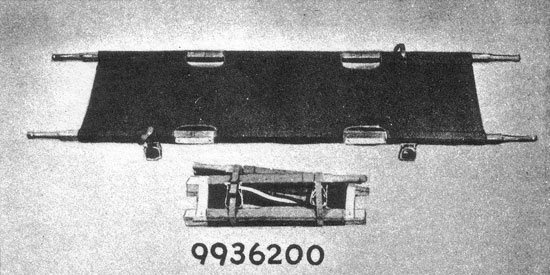
Illustration showing Item # 9936200 Litter, Folding, Wood. The bottom litter shown in the above illustration shows the litter in its folded form.
9936200 – Litter, Folding, Wood:
A modified tri-folding wooden framed Litter was introduced in 1943 for use by Mountain and Airborne troops. Unlike its aluminum non-folding counterpart, the Folding Wood Litter featured squared wooden poles (each 39 inches long), between which was stitched a canvas (with semi-circular cut) also bearing the regular Medical Department designations and maroon Caduceus Insignia within a white circle. The Litter not only collapsed in its long axis, but also folded at its center, by means of socket-type joint near the middle of each pole. The litter was strengthened at its folding locations using an aluminum hinge system. The Litter’s weight was approximately 15 ½ pounds. The first version of the Litter, Canvas, Folding (developed in 1940, and introduced in 1941) had been originally designed by the “Medical Department Field Equipment Laboratory” to permit carrying it on a pack saddle, while at the same time, it lent itself to easy storage in airplanes and other compartments of limited dimensions, hence its first use intended for the Cavalry and the Air Corps, and subsequently widened for issue to Mountain and Airborne troops as well. Due to several complaints, the first version went through several modifications in the course of 1941 and was replaced by the above-mentioned version.

A further illustration showing Item # 9936200 in its folded state, ready for transportation by medical troops to the front line.
The Litter, Folding, Wood (Item # 9936200) consisted of the following components:
- 9936300 – Litter, Folding, Wood, Canvas
- 9936400 – Litter, Folding, Wood, Spreader Bar and Stirrups
- 9937500 – Litter, Folding, Wood, Pole
- 9935900 – Litter Bolt, Stirrup-Securing, for Wood Litter
- 9938300 – Litter Strap, Folding Litter
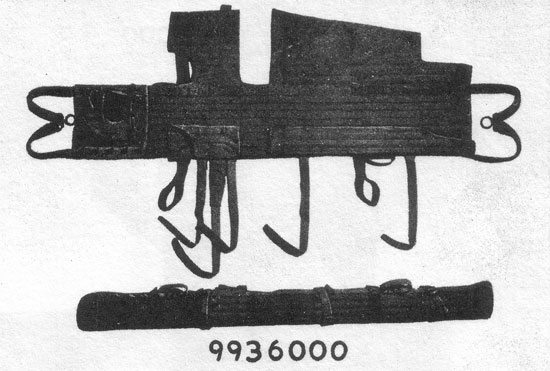
Illustration showing Item # 9936000 Litter, Canvas, Semi-Rigid – also designated as Litter, Mountain
9936000 – Litter, Canvas, Semi-Rigid: (also designated Litter, Mountain)
A frameless canvas Litter strengthened using wooden supports sewn in between two thick layers of canvas. This variation of a Litter was designed by the “Navy Medical Research Institute” based on the British Neil Robertson Stretcher. It was considered to be a cheap and modified version of the Stokes Litter, and was introduced in 1944 for use by Mountain troops, and other personnel who needed to tackle difficult terrain. The Litter consisted of two large canvas flaps which would be wrapped around the casualty, securing him onto the Litter. Manufacturer: Prescott Wilson Inc. Markings consisted of all-black Caduceus and MD designations.
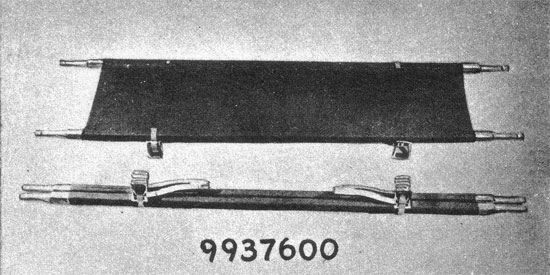
Illustration showing Item # 9937600 Litter, Straigh, Steel. As can be seen from the illustration, the litter was similar in design to Item # 9935000.
9937600 – Litter, Straight, Steel:
Similar in design to Item # 9935000, although only introduced in 1943 as a war economy model designed to make cutbacks to save on the rather expensive and high-demand aluminum metal. Shortages in the War industry warranted a new study, and aluminum poles were now replaced by tubular steel poles (1 ¼ inches in diameter and 77 inches in length), while stirrups and jointed spreader bars were now made of galvanized metal.
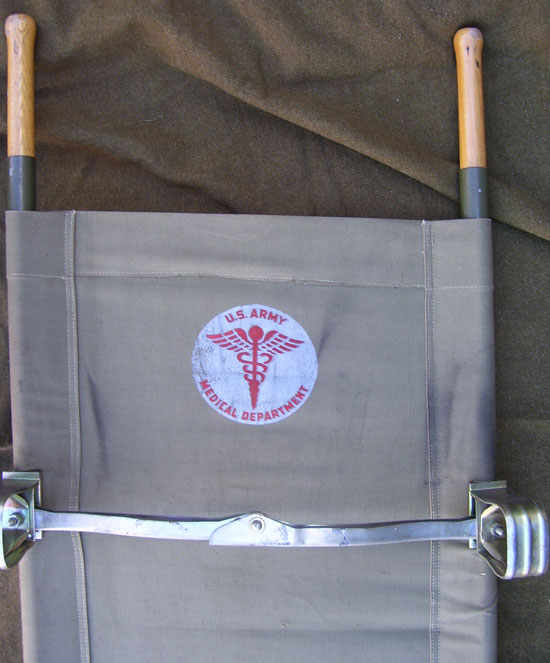
Illustration showing Red and White Caduceus and accompanying text insignia on Item # 9937600
Courtesy of Roger W. Dean
The Litter, Straight, Steel (Item # 9937600) consisted of the following components:
- 9937700 – Litter, Straight, Steel, Spreader Bar and Stirrups
- 9937800 – Litter, Straight, Steel, Canvas
- 9937900 – Litter, Straight, Steel, Handle
- 9935800 – Litter Bolt, Stirrup-Securing, for Straight Steel Litter
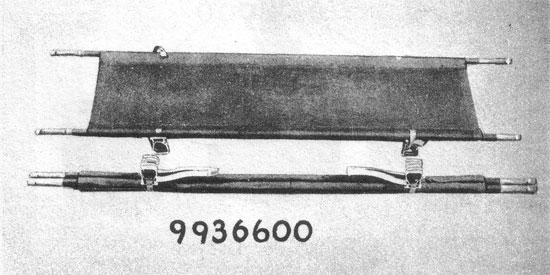
Illustration showing Item # 9936600 Litter, Straight, Wood, M-1943.
9936600 – Litter, Straight, Wood, M-1943:
A wooden framed non-folding Litter was introduced early in 1944. On the one hand it was developed to be lighter in design for transportation by Litter Bearers over greater distances, while on the other hand, it was simply modified in view of a temporary shortage of steel. Wood was now selected for the poles. The Litter was marked using the overall black Medical Department Insignia (without circle).
The Litter, Straight, Wood (Item # 9936600) consisted of the following components:
- 9936700 – Litter, Straight, Wood, M-1943, Canvas
- 9936400 – Litter, Straight, Wood, M-1943, Spreader Bar and Stirrups
- 9936800 – Litter, Straight, Wood, M-1943, Pole
- 9935900 – Litter Bolt, Stirrup-Securing, for Wood Litter
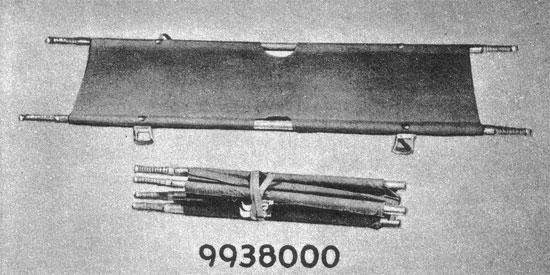
Illustration showing Item # 9938000 Litter, Folding, Aluminum. The illustration shows the litter both in its regular form, and its collapsed folded position.
9938000 – Litter, Folding, Aluminum:
A bi-folding aluminum-framed Litter designed for use once again by primarily Airborne troops, and sometimes, although not often, issued to Mountain troops. The Folding Aluminum Litter was secured in its folded position using Item # 9938300; Litter Strap, Folding Litter.
The Litter, Folding, Aluminum (Item # 9938000) consisted of the following components:
- 9938200 – Litter, Folding, Aluminum, Canvas
- 9935300 – Litter, Folding, Aluminum, Handle
- 9935600 – Litter, Folding, Aluminum, Spreader Bar and Stirrups
- 9938300 – Litter Strap, Folding Litter
- 9935800 – Litter Bolt, Stirrup-Securing, for Aluminum Litter
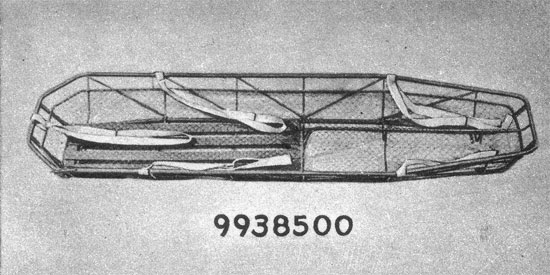
Illustration showing Item # 9938500 Litter, Metal, Stokes. The illustration clearly shows the straps inside the cage for securing the casualty.
9938500 – Litter, Metal, Stokes:
A metal cage or basket-design Litter which was intended to be used by Mountain troops to transport sick and wounded personnel down steep mountain faces. It was composed of a rigid steel tubular frame supporting a wire mesh netting to form a bed. It also was provided with wooden slats to support the patient’s back. The lower half was divided into two compartments to accommodate the patient’s legs. It was equipped with five web securing straps for when the patient was tilted. It had ropes, cables, or steel rings that could be attached to the Litter as required for vertical recoveries. The “Stokes” Litter was 84 inches long, 23 inches wide, and 8 inches deep. Its weight was approximately 31 1/2 pounds. The Stokes Litter was very much in use by the Navy, for loading and transferring patients from small boats to large Hospital ships or transports, and was used to a limited extent by the Army Air Forces. A modified Stokes Litter was later introduced, with a simplified metal frame, and its overall weight was reduced to 20 pounds.
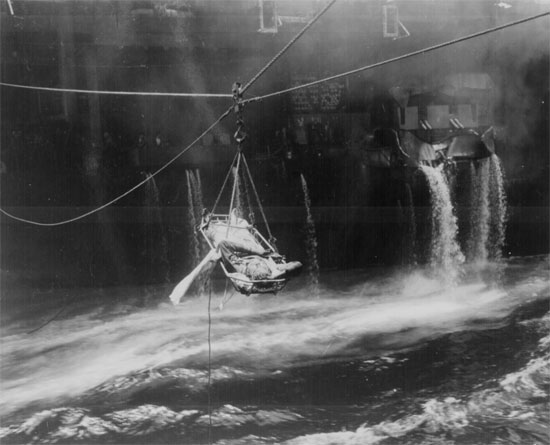
Transfer of wounded from USS BUNKER HILL to USS WILKES BARRE, who were injured during fire aboard carrier following Jap suicide dive bombing attack off Okinawa, May 11, 1945
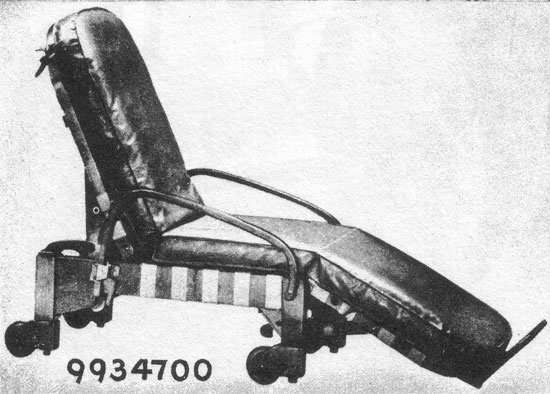
Illustration showing Item # 9934700 Litter, Ambulance, Cot.
9934700 – Litter, Ambulance, Cot:
A folding metal guerny designed for use in military ambulance vehicles. The Litter featured two folding sections which allowed it to be adjusted for the needs of the patient. A small foot rest was fixed to the bottom of the litter, and two arm rests to the sides. The litter also featured four large caster wheels which could be used for inserting and removing the stretcher from the ambulance. It was constructed using a metal frame, covered in a large padded mattress. This litter was officially designated the Bomgardner type. The Litter was complete with two anchoring attachments for securing it inside the ambulance.
9901700 – Adapter, Toboggan Litter:
This was a simple adapter, which allowed any US Army Litter to be attached to a standard toboggan. It was designed to allow transportation of the wounded along snow-covered mountain faces. Two each of Item # 9901700 were required for every toboggan when a Litter was to be attached.
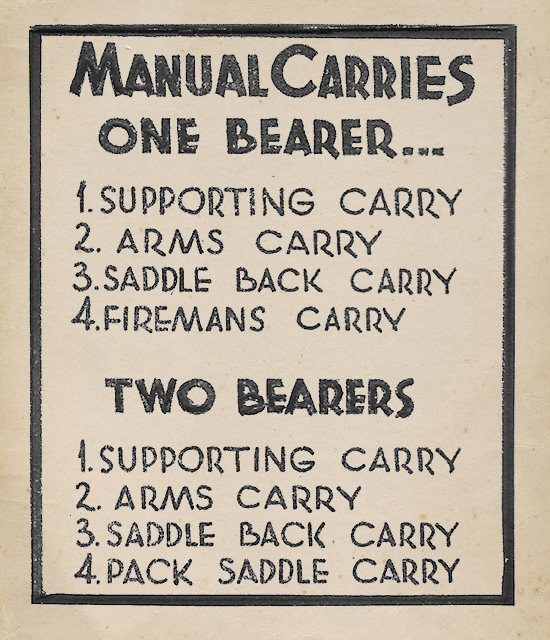
Manual Transportation of Sick and Wounded by 1or 2 Bearers.
Additional Notes:
Metal or Wood – it should be noted that periodical shortages of certain strategic materials in the War industry, influenced both development and production of certain Litter elements. These events created difficulties for manufacturers who had to switch over from one type of raw material to another. The only contracts which did not suffer from Government changes and priorities, were those utilizing natural resources such as wood (plentiful at the time). Thanks to the special measures taken by the Administration, aluminum and steel again became available in large quantities on the market, after the summer of 1943. The re-introduction of steel and aluminum Litters caused resentment with medical personnel. February 1944; due to complaints from the field, regarding the difference in weight between metal and wood, the Medical Department decided to stop the production of steel Litters, and to only allow production of the Aluminum Straight Litter and the Wood Folding Litter.

Illustration showing the various markings available on US Army Litters:
(A) 1940-1942 – Greek Red Cross, with abbreviated designation MED. DEPT. U.S.A. in black, often followed by the manufacturing date in black (no circle)
(B) 1943 – red Caduceus, with designations U.S. ARMY and MEDICAL DEPARTMENT in red, on a full white circle
(C) 1944 – black Caduceus, with designations U.S. ARMY and MEDICAL DEPARTMENT in black, with a black circle contour line (circle outline only)
(D) 1944-1945 – black Caduceus, with designations U.S. ARMY and MEDICAL DEPARTMENT in black (no circle) – also applied in maroon or red, although in the end, black was to prevail.
Litter Canvas Markings – it should be noted that at the outbreak of WW2, the new MD Caduceus Insignia (new style design) was not yet applied on the Litter canvas. From 1940 up to the end of 1942, a classic simple Greek Red Cross was printed at one end of the canvas bed , and under this cross came a a short black text in one line, stating MED. DEPT. U.S.A. followed by black numbers in another single line indicating date of manufacture, such as 5 – 22 – 42 (i.e. 22 May 42). From 1943 onwards, the new-style maroon-red Caduceus within a white circle, with the maroon-red letters U.S. ARMY and MEDICAL DEPARTMENT became standard issue. The end of 1943, brought additional amendments due to more strict camouflage principles, whereby the conspicuous white circle was to be deleted. Caduceus and texts were also affected, and variations of maroon, red, or black Caduceus Insignia and USA / MD designations were now more common. In the end, only black was to prevail.
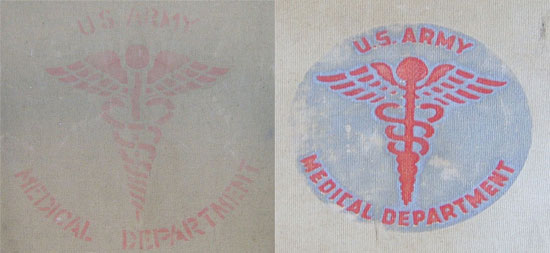
Illustration showing two variations of the litter canvas markings, as located on period US Army Stretcher canvases.
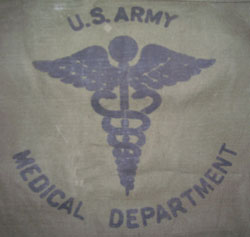
Color illustration showing the later war black Caduceus and Text insignia as found on Litters.
Litter Manufacturer Markings – Different manufacturers were responsible for the production of Litters. Some of these go back from 1940 to 1945, such as Zimmer Splint Co. (e.g. November 25, 1940), Simmons Co. (e.g. August 24, 1942; April 23, 1943), Zimmer-Thomson Corp. (e.g. 1942, 1944, and 1945), and Lake City Mach. Shop (May 15, 1944).
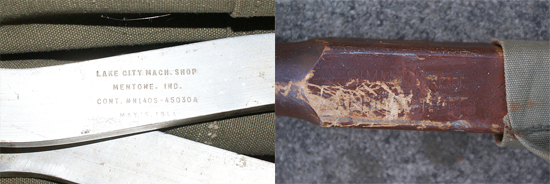
Illustration showing manufacturer markings on the US Army Litters.
Left: Lake City Machine Shop, Mentone, Indiana, May 15, 1944
Right: Simmons Company, April 23, 1943
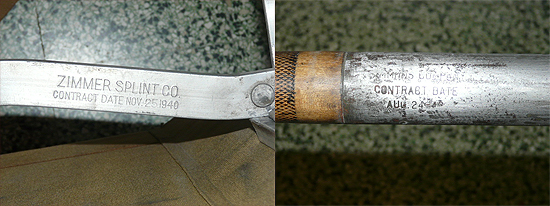
Illustration showing manufacturer markings on the US Army Litters.
Left: Zimmer Splint Company, November 25, 1940.
Right: Simmons Company, August 24, 1942.
Courtesy Pieter Dejonghe
Litter-related Equipment:
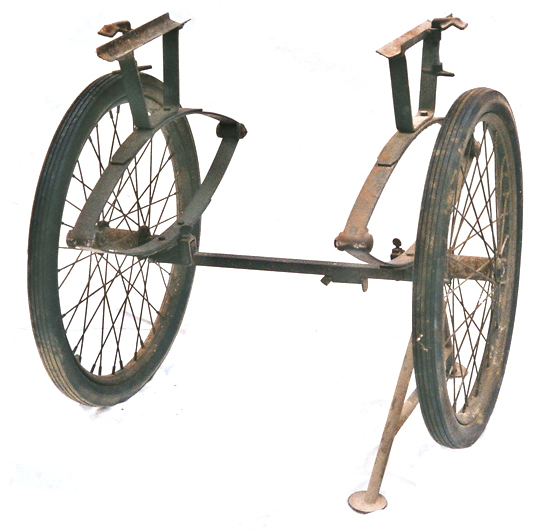
Illustration showing Item # 9917500 Carrier, Field, Collapsible. The illustration above shows the Litter Carrier, although it is only shown complete here, and not in its collapsed state. This example was manufactured by the Jerald Sulky Company.
Picture courtesy Nelson Dionne.
9917500 – Carrier, Field, Collapsible:
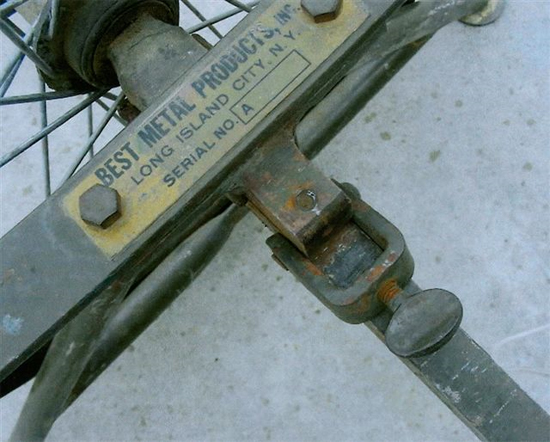
Partial view of a Collapsible Field Carrier, Item 9917500, manufactured by Best Metal Products, Inc., Long Island City, New York.
Picture courtesy Dave Little.
This Carrier was a collapsible 2-wheeled cart designed for carrying one loaded Litter over long distances. It featured two large wire-spoke bicycle wheels with pneumatic tyres size 26 by 2, and also featured a single leaf suspension system. These carts were manufactured by The Colson Corp., Elyria, Ohio, the Best Metal Products, Inc., Long Island City, New York, Dayton Wheel Co, Dayton, Ohio, and the Jerald Sulky Co., Waterloo, Iowa. These Collapsible Field Carriers were often seen at Field Hospital facilities, although photographic evidence exists which suggests that the Carts were used closer to the frontline too, and in different Theaters. The Carrier’s weight was 59 pounds, its width 32 ½ inches, its height 31 inches, and its length 28 inches. When open, the Carrier was held in upright position by a hinged tubular, metal inverted V-shaped stand, which could be folded when not in use. This version replaced the old Wheeled Litter Carrier, with wooden spoke solid rubber tyres, buggy type, and higher weight, 72 pounds.
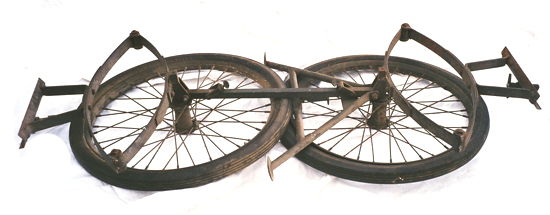
Illustration showing the Collapsible Field Carrier in its collapsed arrangement for transport.
Picture courtesy Nelson Dionne.

Illustration showing the use of Item # 9917500 in the field.
9708000 – Litter Strap:
A First Aid Kit Component web Strap designed to help alleviate the weight of the Litter + Patient. Two web Litter-Carrying Straps were included in the individual equipment of the Medical Department soldier. These Straps (with metal sliding loops) were attached by snaps to the forward and rear rings of the Suspender (Item # 9709500) and the handles of the Litter inserted into the slings thus formed.
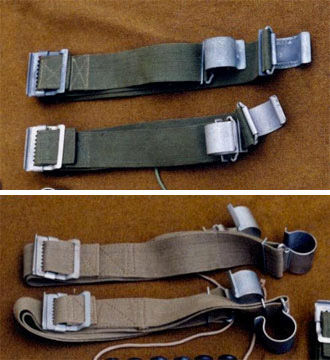
Item # 9938600 – Litter, Securing Strap. Top: Olive-Drab # 7 version. Bottom: Olive-Drab # 3 version.
9938600 – Litter, Securing Strap:
A kind of elasticated canvas Strap designed to secure the patient to the Litter. The straps featured two sprung metal clips attached to either end, and designed to fit around the tubular poles of the Litter. The strap was adjustable, and according to the Medical Supply Catalog of 1 March, 1944:
For securing patient to litter: 4 required per litter. For use with Items 7844000, 9935000, 9936200, 9936600, 9937600 and 9938000.
Litter Improvisation:
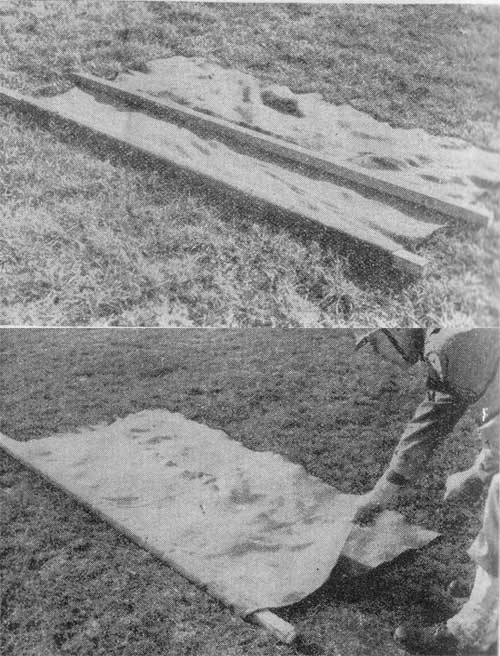
Illustration taken from FM 21-11, FIRST AID FOR SOLDIERS; clearly showing the use of wooden poles and a US Army Blanket in the construction of an improvised litter.
In absence of actual Litters, satisfactory substitutes could be improvised. Products varied with the materials at hand and the ingenuity of the individuals concerned. Following improvisations were suggested by MD literature:
- Improvised Rifle Litter – with rifle barrel inserted through each sleeve of an overcoat, turned inside out and fully buttoned, sleeves inside, and collar toward rifle butts
- Improvised Rifle Litter – with blanket folded from side to side, and two rifles laid transversely upon the blanket, with butt and muzzle projecting beyond the blanket edges (similar method used with two or three blouses or jackets)
- Improvised Pole Litter – with blanket and two wooden or metal poles
- Improvised Poles, Blouses, Overcoats Litter – with either two poles and three blouses, or with two poles and two overcoats
- Improvised Pole and Shelter Half Litter – with two poles and one shelter half
- Improvised Litter with Miscellaneous Items – with two poles as a basis, and cloth sacks, jute bags, bedticks, matting, rugs, carpets, woven rope, rawhide strips, or similar items
- Improvised Litter with Litter-shaped Objects – with common items, such as padded camp cots, wooden doors, benches, ladders, etc.
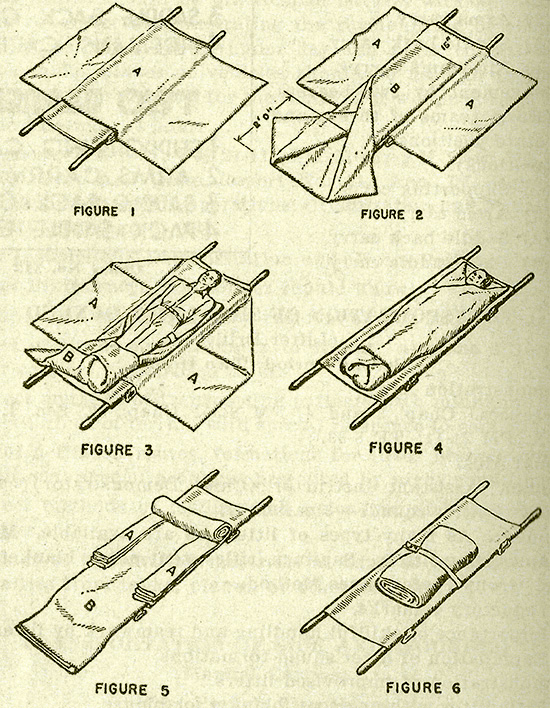
Preparing the Litter and method of blanketing casualties.
Litter Carrying Jeeps:
The fast moving pace of WW2 brought with it an inherent need for rapid evacuation of wounded personnel from the battlefield. As a result, some units began to adapt vehicles at their disposal for carrying Army Litters. The ubiquitous and sturdy 1/4-Ton Truck was one of the preferred vehicles to be modified and adapted. Many of these modifications were simply done in the field by the medical personnel themselves, although sometime towards the end of the war, the then Surgeon General requested that each Division drew up plans of their modifications.
Litter racks can be found in a plethora of designs and materials, and a number of different methods for securing the Litters to the vehicle were used. Above are a number of examples of period illustrations showing the use of the Litter racks on modified vehicles. Below are shown illustrations drawn up by Colonel H. W. Doan for the Chief Surgeon upon his request.
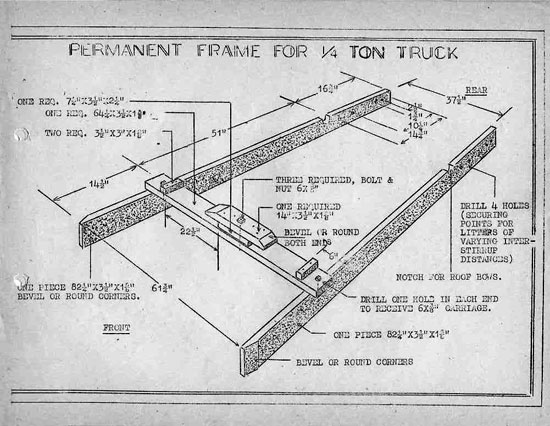
Illustration showing period WW2-drawn plans for a permanant Litter Rack designed for use on the 1/4 Ton Truck. The rack itself was designed in such a way to allow it to be constructed of materials typically found in the field.
The standard ¼-Ton Truck (aka Jeep) was designed to carry a load of 800 pounds. A man and his equipment will weight about 200 lbs. Four (4) men constitute a full payload for the vehicle; a driver plus 3 patients; or a driver, assistant driver, and 2 patients. Two (2) patients can be carried on a Jeep without any special racks or alterations. This method implies that one litter is placed crosswise and extends about 1½ feet over the sides of the vehicle. Another litter is placed lengthwise next to the driver on the vehicle (see illustration).
Another method may be used which requires some adaptations in the form of additional supports. Two (2) litter patients will then be carried lengthwise, next to each other; one behind the driver, and one behind the assistant driver.

Method of Transportation of Sick and Wounded by ¼-Ton Vehicle.
